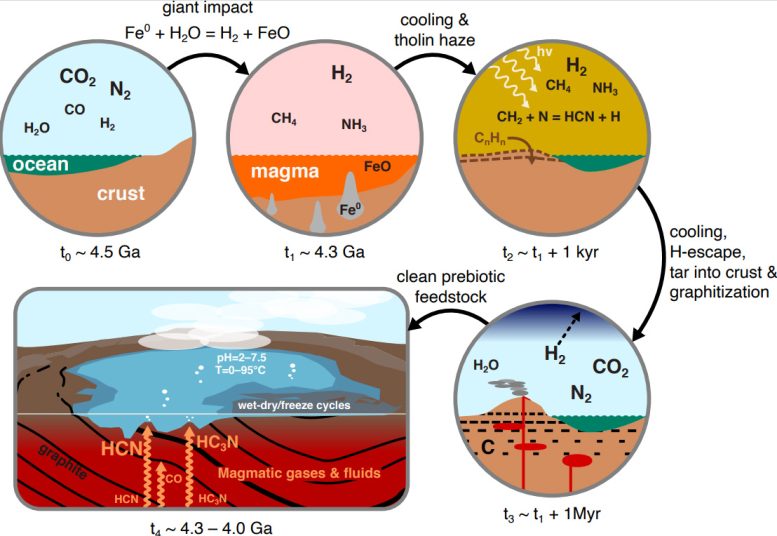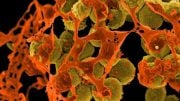
Researchers at Cambridge University have identified a process called graphitization, which they theorize could produce essential life-building molecules like proteins, phospholipids, and nucleotides on early Earth. This process, highlighted in a study in the journal Life, suggests that the high temperatures resulting from celestial impacts and interactions with iron and water could simplify chemical environments, making them conducive to the formation of life’s necessary components.
Researchers at Cambridge University propose that essential molecules for life’s development might have originated from a process called graphitization. If confirmed through laboratory experiments, this could enable us to simulate conditions that are likely to have led to the emergence of life.
How did the chemicals required for life get there?
It has long been debated how the seemingly fortuitous conditions for life arose in nature, with many hypotheses reaching dead ends. However, researchers at the University of Cambridge have now modeled how these conditions could occur, producing the necessary ingredients for life in substantial quantities.
Life is governed by molecules called proteins, phospholipids, and nucleotides. Past research suggests that useful molecules containing nitrogen like nitriles – cyanoacetylene(HC3N) and hydrogen cyanide(HCN) – and isonitriles – isocyanide(HNC) and methyl isocyanide(CH3NC) – could be used to make these building blocks of life. As of yet though, there has been no clear way to make all of these in the same environment in substantial amounts.
In a recent study published in Life, the group has now found that through a process known as graphitization, significant quantities of these useful molecules can be theoretically made. If the model can be verified experimentally, this suggests that the process was a likely step for early Earth on its journey toward life.
Why is this process more likely to have occurred than others?
Much of the problem with previous models, is that a range of other products are created along with the nitriles. This makes a messy system that hinders the formation of life.
‘A big part of life is simplicity,’ said Dr Paul Rimmer, Assistant Professor of Experimental Astrophysics at the Cavendish Laboratory, and co-author of the study. ‘It’s order. It’s coming up with a way to get rid of some of the complexity by controlling what chemistry can happen.’
We don’t expect life to be produced in a messy environment. So, what is fascinating is how graphitization itself cleans the environment, since the process exclusively creates these nitriles and isonitriles, with mostly inert side-products.

A schematic representation of the scenario we propose here for clean, high-yield production of prebiotic feedstock. Events move around clockwise from the top left: First, the Earth has a neutral atmosphere. This is reduced following a giant impact at 4.3 Ga by oxidation of the impactor’s metal core to produce a massive H2 atmosphere with significant methane and ammonia. This atmosphere quickly cools (in <1 kyr), with photochemistry producing a tholin-rich haze that deposits complex nitrogen-rich organics. These organics become progressively buried and graphitized by interaction with magma. The atmosphere clears as H2 is lost to space and becomes neutral again. Finally, magmatic gases interact with the graphite and are scrubbed to produce high yields of clean HCN, HC3N, and isonitriles. Credit: Oliver Shorttle
‘At first, we thought this would spoil everything, but actually, it makes everything so much better. It cleans the chemistry,’ said Rimmer.
This means graphitization could provide the simplicity scientists are looking for, and the clean environment required for life.
How does the process work?
The Hadean eon was the earliest period in Earth’s history, when the Earth was very different from our modern Earth. Impacts with debris, sometimes the size of planets, were not unheard of. The study theorizes that when the early Earth was hit by an object roughly the size of the moon, around 4.3 billion years ago, the iron that it contained reacted with water on Earth.
‘Something the size of the moon hit early Earth, and it would have deposited a large amount of iron and other metals’ said co-author Dr Oliver Shorttle, Professor of natural philosophy at the Institute of Astronomy and Department of Earth Sciences in Cambridge.
The products of the iron-water reaction condense into a tar on the surface of the Earth. The tar then reacts with magma at over 1500°C and the carbon in the tar becomes graphite- a highly stable form of carbon- and what we use in modern pencil leads!
‘Once the iron reacts with the water, a mist forms that would have condensed and mixed with the Earth’s crust. Upon heating, what’s left is, lo and behold, the useful nitrogen-containing compounds,’ said Shorttle.
What evidence exists to support this idea?
The evidence to support this theory partly comes from the presence of komatiitic rocks. Komatiite is a type of volcanic rock which are formed when very hot magma(>1500°C) cools.
‘Komatiite was originally found in South Africa. The rocks date back to around 3.5 billion years ago,’ said Shorttle. ‘Crucially, we know that these rocks only form at scorching temperatures, around 1700°C! That means the magma would already have been hot enough to heat the tar and create our useful nitriles.’
With the link confirmed, the authors suggest that nitrogen-containing compounds would be made via this method- since we see komatiite, we know the temperature of magma on early Earth sometimes must have been in excess of 1500°C.
What next?
Now experiments must try to recreate these conditions in the lab, and study whether the water, which is inevitably in the system, eats up the nitrogen compounds, breaking them apart.
‘Though we don’t know for sure that these molecules started out life on Earth, we do know that life’s building blocks must be made from molecules that survived in water,’ said Rimmer. ‘If future experiments show that the nitriles all fall apart, then we’ll have to look for a different way.’
Reference: “A Surface Hydrothermal Source of Nitriles and Isonitriles” by Paul B. Rimmer and Oliver Shorttle, 10 April 2024, Life.
DOI: 10.3390/life14040498
The study was funded by Cambridge Planetary Science and Life in the Universe Research Grants.









Why we can’t take it that simple! You can’t rule out trillions of relative conditions necessary within the entire universe to establish something (bio molecule) beforehand, which is implicitly necessary only to create something (bio molecule) that must survive electromagnetic microwaves, eg, from distant quasars to the nearby hostile conditions on Earth itself. It’s not that simple or proven in a lab.
The early date and fecund diversification of evolution show that it is that simple, or actually simpler (see my response to the article).
Creation of life, as well as other complex systems, must be an intentional, mindful process. Do you really start the Universe, e.g. from the Big Bang, with the lowest level of entropy? Where was all this information stored within the most uniform matter? Sir Roger Penrose suggests that gravity has not been uniform and contained the information. By a similar token, while forming, large cosmic objects, such as stars and planets, can acquire consciousness and mind by virtue of their large mass and density, in turn generating life as we know it. Religions do not try and explain the process, neither does mainstream evolutionary science.
Evolution is a natural process, and we now know it was evolution all the way. And we do have a perfectly fine explanation for evolution in population genetics, which is about a century old now.
All your key notions, of “creation”, “entropy”, “information” et cetera suggest that you are trying to spam a science site with observably erroneous superstition. We *also* since 2016 robustly know beyond reasonable doubt, that the universe is produced by an entirely natural space expansion process, rejecting religious magic ‘explanations’. Religion is now, if not before, a shame on humanity.
Are you familiar with pertinent works of R. Penrose, F. Hoyle, F. Crick, to name a few? Would you think their knowledge of mathematics and probability theory, and biology in general for that matter are inferior to yours? I guess, you just are not able to see the relevance of the topic that has been debated by the most brilliant scientific minds since the introduction of Darwinism, regarding the problem of origins of matter, life and consciousness – let alone to understand the reasons and content of the debate. It is NOT science v. religion. It is that Darwinism despite its wildly self-proclaimed scientific attire is just an extension of the Judeo-Christian worldview (hence you’re resorting to the term “shame” in your posts, twice), with totally absent power to explain reality – compared to preexisting philosophies that paved ways to modern physics and mathematics – simply because it is flawed by all measure completely disregarding laws of math and. You are just not curious enough to even try to understand the reasons, much like all mainstream biologists that keep repeating how Dawin was great and how great the explanatory power of his theory is, and how R. Fisher’s population genetics is the king of the bunch, no matter how much Port was habitually poured in it, while the “theory” is actually the most single disservice to science in the modern human history.
This is great. People want to rush 3 billion years to do a minimal thing because of how hurried life seems at a nominable endpoint, and this is an mvp to it. Great feathered beasts in 999 moves can be nextish.
Life requires amino acids to form peptide bonds leading to proteins. These have been found in meteorites. This complicated and silly idea of graphite leading to life is unnecessary..
Ken – Indeed, panspermia has been suggested from ancient Greeks to modern scientist including Sir Fred Hoyle and Francis Crick. That implies extraterrestrial origins. While most things are extraterrestrial for that matter, why would not forming the first living organisms here on Earth be good enough? Alternatively, you bring some in meteors or comets, so that they start multiplying and evolving here somehow getting rid of the huge mutational load, acquiring new information along the way to reaching higher levels of complexity, etc. (randomly changing and reshuffling information bearing molecules will not do a thing or you would need to select among the dead only). If most has been done on Earth, which is what has happened obviously, we do need to study and discover new, still unfamiliar to us ways that transform prebiotic molecules. I think studying graphitization to this end is a good step in the right direction.
For the wrath of God is revealed from heaven against all ungodliness and unrighteousness of men, who by their unrighteousness suppress the truth. For what can be known about God is plain to them. For his invisible attributes, namely, his eternal power and divine nature, have been clearly perceived, ever since the creation of the world, in the things that have been made. So they are without excuse. For although they knew God, they did not honor him as God or give thanks to him,but they became futile in their thinking, and their foolish hearts were darkened. Romans Chapter 1.
You are spamming a science site with observably erroneous superstition. Since 2016 we robustly know beyond reasonable doubt that the universe is produced by an entirely natural space expansion process. This rejects religious magic ‘explanations’.
Religion is now, if not before, a shame on humanity.
Unless I somehow missed it the article missed explaining how these chemicals once created result in life.
I’m not very conversant with the minority biochemistry work on early evolution since it has fallen out of favor. But I know they have wanted to show that enough simple and stable pathways to produce nucleic acids could avoid the complexity of early Earth geology, since they can’t grok how that would work. Typically they need simple “bath” systems that batch process chemicals through wet-and-dry cycling to concentrate and drive reactions. This suggest, as the title of the paper says, surface hydrothermal systems.
There are problem with this. The biological data, for a long time and now explicitly, says evolution from non-life (metabolism) over half-alive (open cells) to alive (closed) cells happened in the wet and complex environment at the bottom of a deep ocean. That early Earth likely had a global ocean, with no or rare volcanic islands, is also now a geological main hypothesis based on data.
Additionally we now know that enough acidic and convective hot environments and vents can even produce random proteins in significant amounts despite that it is energetically disfavored. In fact ocean vent models have been shown to produce and concentrate significant enough amounts of early life nutrients in geological pores around such vents.
So what the biochemist minority suggests is orthogonal to, or even problematized by, what other scientists observe.
“However, researchers at the University of Cambridge have now modeled how these conditions could occur, producing the necessary ingredients for life in substantial quantities.”
The assumed necessary ingredients of the minor biochemist theory of early life are uninteresting now that we have the first biologically founded phylogenies that covers the split between geology and biology. [Weiss, M., Sousa, F., Mrnjavac, N. et al. The physiology and habitat of the last universal common ancestor. Nat Microbiol 1, 16116 (2016).] They identify the deep global ocean hydrothermal vents, where we know from experiments that the cellular metabolic core could form and be mostly self driven. [Wimmer et al. Energy at Origins: Favorable Thermodynamics of Biosynthetic Reactions in the Last Universal Common Ancestor (LUCA), Front. Microbiol., 13 December 2021.]
No doubt these sources of organics contributed to the environmental supply, but they don’t seem critical.
A nitpick is that the suggested 4.3 billion date is unrealistic. In the recent months a first plausibel dating of the root of early life has been made with a cross bracing method that for the first time pull back the date from the naive “as early as possible” of earlier methods. The 4.4 billion date is consistent with the first zircon evidence of a seemingly global ocean. [Dated Tree Of Life shown in Tara A. Mahendrarajah’s The Conversation article Extreme environments, for details see her published research.]